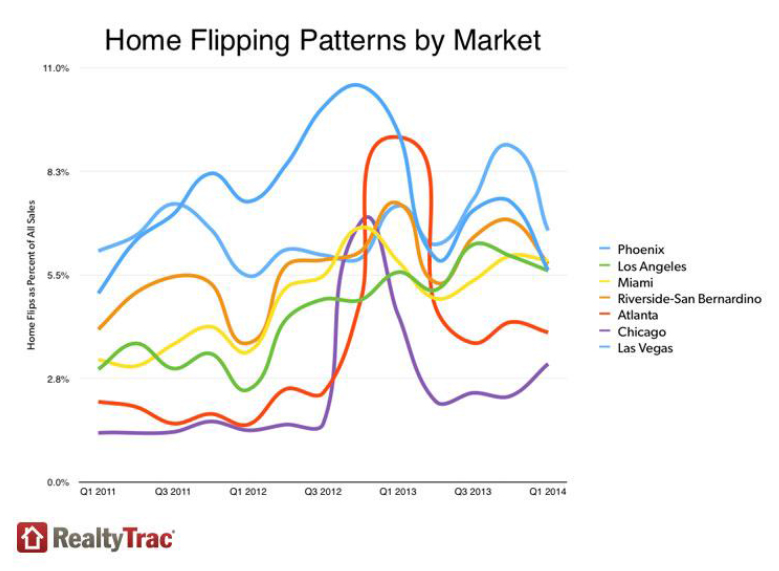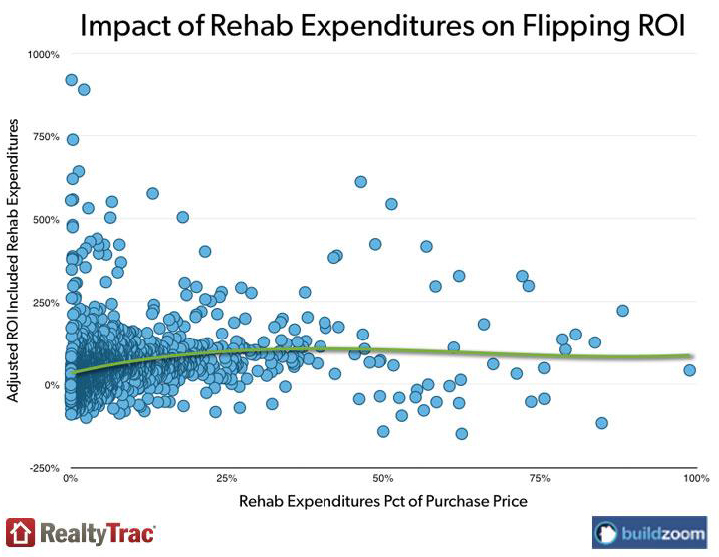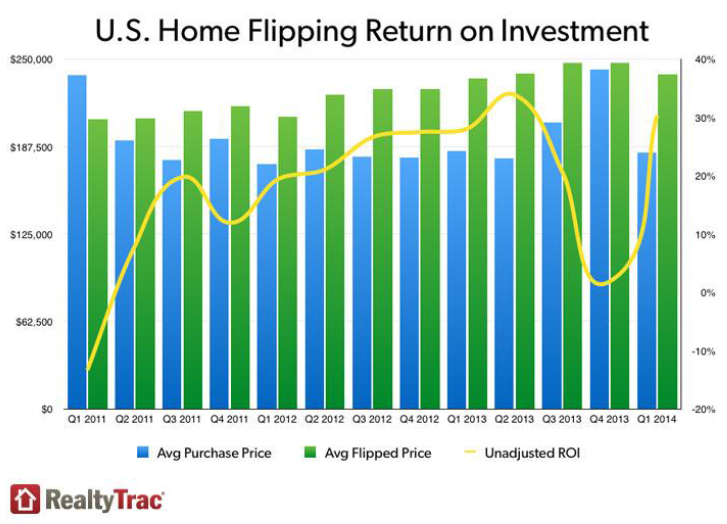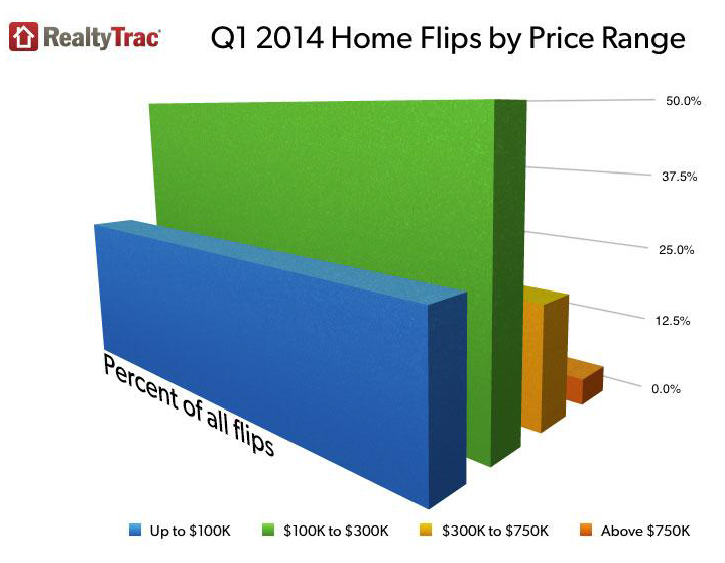The WPJ
THE WORLD PROPERTY JOURNALReal Estate Facts Not Fiction
Residential Real Estate News

Home Flipping Slows in U.S., Investors Fear 'Flying too Close to the Sun'
Residential News » North America Residential News Edition | By Michael Gerrity | May 1, 2014 8:00 AM ET
According to RealtyTrac's U.S. Home Flipping Report for the first quarter of 2014, 3.7 percent of all U.S. single family home sales were flips -- where a home is purchased and subsequently sold again within six months -- in the first quarter of 2014, down from 4.1 percent in the fourth quarter of 2013 and down from 6.5 percent in the first quarter of 2013.
The average sales price of single family homes flipped in the first quarter was $55,574 higher than the average original purchase price. That gross profit provided flippers with an unadjusted ROI (return on investment) of 30 percent of the average original purchase price. The average gross profit per flip a year ago was $51,805 for an unadjusted ROI of 28 percent.
"Slowing home price appreciation early this year in many of the most popular flipping markets put some investors in danger of flying too close to the sun," said Daren Blomquist, vice president at RealtyTrac. "But investors appear to have recalibrated their flipping strategy, accounting for the slower home price appreciation even if that means fewer flips. This is another good sign that this housing recovery is behaving much more rationally than the last housing boom, which was built largely on unfounded speculation rather than fact-based calculations."
Other high-level findings in the report:
- Flips completed in the first quarter took an average of 101 days to complete, up from an average of 92 days in the previous quarter and up from an average of 79 days for flips completed in the first quarter of 2013.
- Among metro areas with a population of at least 1 million and at least 25 single family homes flipped in the first quarter, those with the highest share of flips in the first quarter were New York (10.2 percent), Jacksonville, Fla., (10.0 percent), San Diego (7.1 percent), Las Vegas (6.7 percent) and Miami (5.9 percent).
- Among metro areas with a population of at least 1 million and at least 25 single family homes flipped in the first quarter, those with the highest average gross ROI percentage on single family homes flipped in the first quarter were Pittsburgh (89 percent), Philadelphia (56 percent), Memphis (51 percent), Detroit (48 percent), and Seattle (48 percent).
- Among those same major metros, those with the biggest increase from a year ago in home flipping as a share of all sales were San Antonio (up 52 percent), Nashville (up 50 percent), Indianapolis (up 47 percent), Austin (up 35 percent), Providence, R.I. (up 33 percent), and Oklahoma City (up 33 percent).
- Other major markets with year-over-year increases in flipping as a share of all sales included Los Angeles (up 1 percent), Dallas (up 28 percent), Seattle (up 19 percent), Houston (up 29 percent), and Portland (up 2 percent).
- Among major metros, those with the biggest decrease from a year ago in home flipping as a share of all sales were New Orleans (down 83 percent), Baltimore (down 81 percent), Minneapolis (down 80 percent), Richmond, Va. (down 80 percent), Detroit (down 76 percent), and Washington, D.C. (down 73 percent).
- Other major metros with year-over-year decreases in flipping as a share of all sales included New York (down 37 percent), Phoenix (down 39 percent), Riverside-San Bernardino in Southern California (down 22 percent), Atlanta (down 57 percent), Chicago (down 29 percent) and Las Vegas (down 9 percent).
- Among all metro areas nationwide those with the highest volume of flips in the first quarter were New York (1,791), Phoenix (894), Los Angeles (828), Miami (749), and Riverside-San Bernardino in Southern California (627).
- 82 percent of all properties flipped in the first quarter were sold to owner-occupants; 18 percent to buyers with a different mailing address than the property.
- 43 percent of all properties flipped in the first quarter were all-cash sales to the new buyer.
- 58 percent of all properties flipped in the first quarter were 3-bedroom homes, 21 percent 4 bedroom homes and 17 percent 2-bedroom homes.
- Flips that could be associated with building permits, outperformed the industry average. Unadjusted return-on-investment (ROI) was determined by looking solely at the purchase and sales prices for flipped properties. In the overall set, the median ROI was 13 percent compared to 50 percent across flips with at least one permit.
- The median expenditure on improvements for flips during the three-year time period was $4,800, representing 3.34 percent of the original purchase price of the property.
- Cities with the highest median improvement expenditures for flips were Atlanta ($18,250), Scottsdale, Ariz. ($14,772) and San Francisco ($13,900).
- Improvement expenditures were analyzed to measure their impact on adjusted ROI. The results indicate that increasing expenditures result in increasing ROI up to the point at which the expenditure represents around 23% of the original purchase price, at which point further expenditures result in diminishing returns.
- Flips were broken into quartiles, based on the size of the improvement expenditure. Investors in the top quartile (who spent the most) experienced the highest ROI whereas those in the bottom quartile experienced the lowest ROI.
- In San Francisco, ROI was analyzed based on the type of improvements performed. Kitchens, bathrooms and windows were all strong indicators of a high ROI.




Sign Up Free | The WPJ Weekly Newsletter
Relevant real estate news.
Actionable market intelligence.
Right to your inbox every week.
Real Estate Listings Showcase
Related News Stories
Residential Real Estate Headlines
- U.S. New-Home Sales Surge in August as Mortgage Rates Ease
- Despite Increased Foreign Buyer Activity, Miami Residential Sales Dip 11 Percent in August
- California Home Sales Enjoy Modest Uptick as Mortgage Rates Ease
- U.S. Home-Flipping Profits Sink to Lowest Level Since 2008 Financial Crisis as Costs Climb
- Why the World's Rich Are Flocking to Europe in 2025
- Federal Reserve Delivers First Rate Cut of 2025 as Mortgage Relief Proves Limited
- Homebuilder Sentiment Holds Steady in U.S. as Rate-Cut Bets Lift Outlook
- U.S. Mortgage Rates Experience Sharpest Weekly Drop in Over a Year
- U.S. Foreclosures Rise for Sixth Straight Month as Affordability Pressures Mount
- Black U.S. Homeownership Rate Falls to Two-Year Low as Job Losses Mount
- Las Vegas Home Prices Flatten as Listings Surge, Sales Slow
- Cooling Miami Housing Market Sees 16 Percent Annual Sales Drop in July
- U.S. Mortgage Delinquencies Uptick in June Amid Regional Pressures
- California, Florida Top U.S. Housing Markets Most at Risk of Downturn
- 30-Year Mortgage Drops to 6.56 Percent in Late August, Lowest Since October 2024
- Investors Maintain Elevated Role in U.S. Housing Market Despite Slight Pullback
- Pending Home Sales Show Mixed Signals as U.S. Buyers Remain Cautious
- Canadian Home Sales Extend Recovery in July
- U.S. Home Sales Rise in July as Buyers Gain More Bargaining Power
- Zombie Foreclosures Edge Up Across U.S.
- 2.6 Million Homes at Wildfire Risk Across 14 Western States in 2025
- One in Five Americans Willing to Trade Personal Safety for Home Affordability
- U.S. Home Price Growth Slows as Affordability Pressures Mount in 2025
- U.S. Mortgage Rates Dip to Four Month Low in Early August
- U.S. Mortgage Applications Rise in Late July, Breaking Four-Week Slump
- Hong Kong's Housing Market Stuck in Stalemate as Bulls and Bears Face Off
- U.S. Condo Market Struggles in 2025
- U.S. Pending Home Sales Remain Sluggish in June
- Los Angeles Area Wildfires Destroyed Nearly $52 Billion in Homes Last January
- Greater Palm Beach Area Residential Sales Slip in June Amid Growing Inventory
- Economic Resilience Lifts U.S. Housing Outlook Going Forward
- New Home Sales Stagnate as Affordability Struggles Continue in America
- U.S. Housing Market Slips in June as Prices Hit New Highs
- Florida, California Continue to Reign Supreme as America's Ultraluxury Housing Markets
- Caribbean Housing Market Evolves into Global Second-Home Hotspot
- U.S. Home Sales See Highest June Cancellation Rate on Record
- Orlando Housing Market Cools in June as Listings Slide, Sales Slow
- Private Credit Surges in 2025 as Real Estate Developers Bypass Banks
- U.S. Condo Market Suffers Sharpest Price Drops in Over a Decade as Buyers Retreat
- Rising Taxes, Insurance Costs Undermine the Stability of U.S. Homeownership
Reader Poll
Marketplace Links
This website uses cookies to improve user experience. By using our website you consent in accordance with our Cookie Policy. Read More







